By John Treadwell Dunbar ——Bio and Archives--September 17, 2012
Travel | CFP Comments | Reader Friendly | Subscribe | Email Us
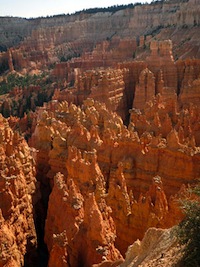 Bryce Canyon isn't a canyon at all, but a twenty-mile-long series of massive eroded amphitheaters carved out of the eastern edge of the verdant Paunsaugunt Plateau, shaped like horseshoes crammed tight with freestanding walls, slots, and windows and fins.
There's nothing like it anywhere in the world that I can think of.
It's even unique by Southern Utah standards which is why it has become so popular, and why it's love at first sight for all comers who are invariably entranced by the million shades of pink, white and orange limestone towers morphed and eroded by the patient force of water, and the heat of the sun.
Bryce Canyon isn't a canyon at all, but a twenty-mile-long series of massive eroded amphitheaters carved out of the eastern edge of the verdant Paunsaugunt Plateau, shaped like horseshoes crammed tight with freestanding walls, slots, and windows and fins.
There's nothing like it anywhere in the world that I can think of.
It's even unique by Southern Utah standards which is why it has become so popular, and why it's love at first sight for all comers who are invariably entranced by the million shades of pink, white and orange limestone towers morphed and eroded by the patient force of water, and the heat of the sun.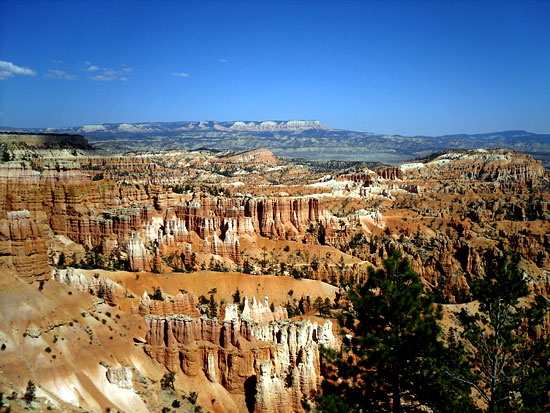 The majority of visitors restrict themselves to the rim, thankfully, while the rest of us plunge right in, down and down the twisting, winding trails through this Manhattan maze of Lilliputian dimensions, where every bend in the way opens up another view unique and all its own; where trails carve through tunnels in this grown-up Alice in Wonderland of pink toothpicks, and coarse, rumpled edges and blatantly obscene remnants of that which remains standing. Bryce Canyon will make you giggle, and you don't even have to be stoned on whatever stones you. It'll make you grateful you're still alive and breathing, and wishing your paltry life could go on forever and ever so you can experience these kinds of things ad infinitum, and be completely and totally overwhelmed in your senses, and brought to your knees in humility. It's that beautiful.
The majority of visitors restrict themselves to the rim, thankfully, while the rest of us plunge right in, down and down the twisting, winding trails through this Manhattan maze of Lilliputian dimensions, where every bend in the way opens up another view unique and all its own; where trails carve through tunnels in this grown-up Alice in Wonderland of pink toothpicks, and coarse, rumpled edges and blatantly obscene remnants of that which remains standing. Bryce Canyon will make you giggle, and you don't even have to be stoned on whatever stones you. It'll make you grateful you're still alive and breathing, and wishing your paltry life could go on forever and ever so you can experience these kinds of things ad infinitum, and be completely and totally overwhelmed in your senses, and brought to your knees in humility. It's that beautiful.
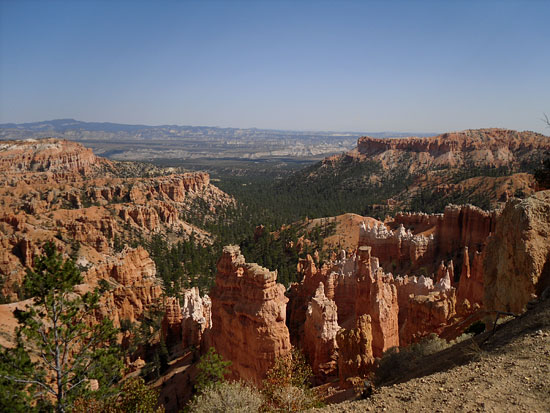 When I recently read that 1.5 million people visited Bryce each year, I didn't realize they'd all show up at the same time, half of them stumbling out of tour buses jabbering away in foreign tongues. But there they were, and who can really blame them? A dose of hantavirus would clear everybody out, I bet. Send everybody packing.
When I recently read that 1.5 million people visited Bryce each year, I didn't realize they'd all show up at the same time, half of them stumbling out of tour buses jabbering away in foreign tongues. But there they were, and who can really blame them? A dose of hantavirus would clear everybody out, I bet. Send everybody packing.
 Here's a fact: Commercial industrial tourism is cannibalizing our most cherished federal parks, ruining them, crowding them to ridiculous levels, militarizing them, turning them into highly-regulated police states determined to keep law and order, keep us all in our places and on our best behavior, and on the trails, and off the pretty flowers.
Here's a fact: Commercial industrial tourism is cannibalizing our most cherished federal parks, ruining them, crowding them to ridiculous levels, militarizing them, turning them into highly-regulated police states determined to keep law and order, keep us all in our places and on our best behavior, and on the trails, and off the pretty flowers.
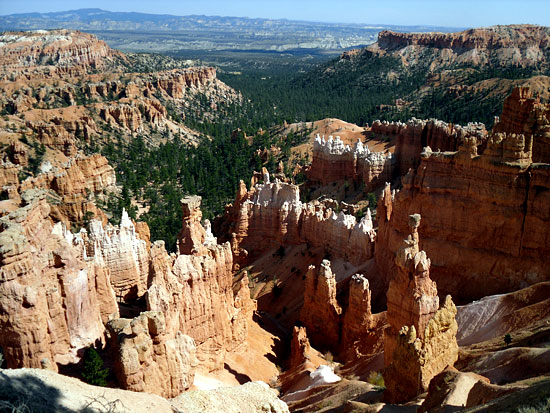 It's inevitable, I suppose, given the exploding numbers and the money to be had by someone out there. But it sure has changed during the last twenty or thirty years when the rangers were friendly and harmless, really good guys and gals, and didn't go out of their way to intimidate you with the .45 and the tazers and the pepper spray and the bullet proof vests. And the S.W.A.T attitudes. Our public lands, even at places like Bryce, are taking on a new face and meaning, to the chagrin I suspect of both liberals and conservatives. Maybe I'm wrong. But I digress. Where was I? Oh, pretty rocks ….
It's inevitable, I suppose, given the exploding numbers and the money to be had by someone out there. But it sure has changed during the last twenty or thirty years when the rangers were friendly and harmless, really good guys and gals, and didn't go out of their way to intimidate you with the .45 and the tazers and the pepper spray and the bullet proof vests. And the S.W.A.T attitudes. Our public lands, even at places like Bryce, are taking on a new face and meaning, to the chagrin I suspect of both liberals and conservatives. Maybe I'm wrong. But I digress. Where was I? Oh, pretty rocks ….
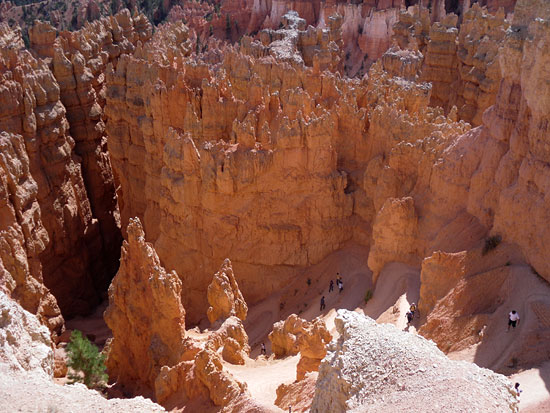 Even though the terrain down in the “canyon” is relatively barren in areas, due to the steep elevation differential - up to 2,000 feet near Rainbow Point at the end of the road - the park contains three climatic zones of pinion-juniper, spruce-fir, and one of my favorite, the ponderosa. The plateau itself is awash in large swaths of forest, and wide open meadows, and fields of grass and purple sage. The retired with their recreational vehicles boon-dock back in these trees, as do elk and deer. At one time the pronghorn antelope, second only in number to the American bison, roamed in vast herds across North America. They're still around in these parts. You can't miss the solitary stag and his harem lounging about. And up until yesterday I hadn't realized that the pronghorn is the fastest land mammal in North America hitting top speeds of 60 miles an hour, and they're the second fastest in the world.
Even though the terrain down in the “canyon” is relatively barren in areas, due to the steep elevation differential - up to 2,000 feet near Rainbow Point at the end of the road - the park contains three climatic zones of pinion-juniper, spruce-fir, and one of my favorite, the ponderosa. The plateau itself is awash in large swaths of forest, and wide open meadows, and fields of grass and purple sage. The retired with their recreational vehicles boon-dock back in these trees, as do elk and deer. At one time the pronghorn antelope, second only in number to the American bison, roamed in vast herds across North America. They're still around in these parts. You can't miss the solitary stag and his harem lounging about. And up until yesterday I hadn't realized that the pronghorn is the fastest land mammal in North America hitting top speeds of 60 miles an hour, and they're the second fastest in the world.
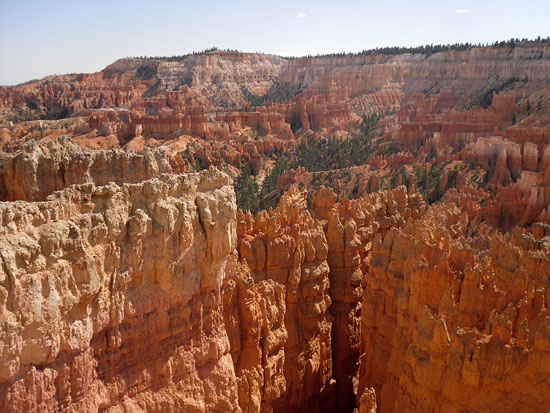 In a land where there are abundant resources, like coal, you will invariably have conflict, and it's no different here. Around ten miles west of Bryce Canyon National Park, the Alton Coal Development Company is planning to expand its strip mining operations, in a very big way, onto federal BLM lands thereby stirring up a hornet's nest of opposition and litigation. The many trucks and the grit, and the dust and noise growling seemingly nonstop through historic and picturesque Panguitch has many locals up in arms. And if the expansion continues, those numbers will increase an incredible five-fold. All of this to fuel a power plant a few hours north that is under contract to supply electricity to smelly Los Angeles.
In a land where there are abundant resources, like coal, you will invariably have conflict, and it's no different here. Around ten miles west of Bryce Canyon National Park, the Alton Coal Development Company is planning to expand its strip mining operations, in a very big way, onto federal BLM lands thereby stirring up a hornet's nest of opposition and litigation. The many trucks and the grit, and the dust and noise growling seemingly nonstop through historic and picturesque Panguitch has many locals up in arms. And if the expansion continues, those numbers will increase an incredible five-fold. All of this to fuel a power plant a few hours north that is under contract to supply electricity to smelly Los Angeles.
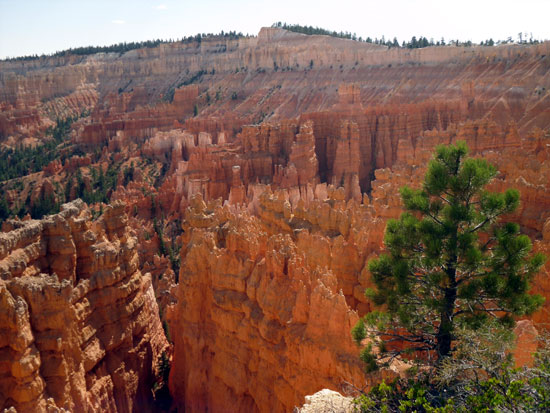 The U.S. Fish & Wildlife Service, the National Park Service and the U.S. Environmental Protection Agency oppose the expansion, as do a number of environmentalists who recognize the impact it would have on the park and the surrounding communities, all of which are part and parcel of the Bryce Canyon experience. On the other side, Utah in general, and the two impacted counties and many if not most locals, see it as a boon in much-needed jobs and revenue over the next twenty years or so. They also have a point. Sort of.
The U.S. Fish & Wildlife Service, the National Park Service and the U.S. Environmental Protection Agency oppose the expansion, as do a number of environmentalists who recognize the impact it would have on the park and the surrounding communities, all of which are part and parcel of the Bryce Canyon experience. On the other side, Utah in general, and the two impacted counties and many if not most locals, see it as a boon in much-needed jobs and revenue over the next twenty years or so. They also have a point. Sort of.
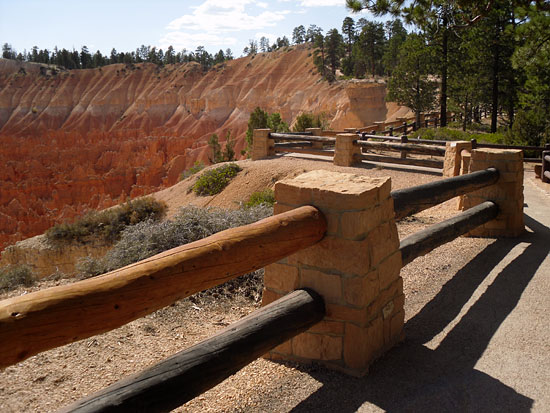 If you've ever been near Alton and the surrounding area you would understand what the fuss is all about. It's clean, quiet, natural, and very close to Bryce Canyon. I can hear it already, that massive sucking sound four million Los Angeles residents make as they siphon off the faraway good land to keep that filthy urban mess down there running. Call me a crazy environmentalist, I don't care. Not every place needs a strip mine, especially this close to heaven on earth. And coal jobs, as desperate as we need employment in this country, don't always trump a competing industry - the 1.5 million visitors who pump countless dollars into the local economy every year, and will do so for a hundred years to come.
If you've ever been near Alton and the surrounding area you would understand what the fuss is all about. It's clean, quiet, natural, and very close to Bryce Canyon. I can hear it already, that massive sucking sound four million Los Angeles residents make as they siphon off the faraway good land to keep that filthy urban mess down there running. Call me a crazy environmentalist, I don't care. Not every place needs a strip mine, especially this close to heaven on earth. And coal jobs, as desperate as we need employment in this country, don't always trump a competing industry - the 1.5 million visitors who pump countless dollars into the local economy every year, and will do so for a hundred years to come.
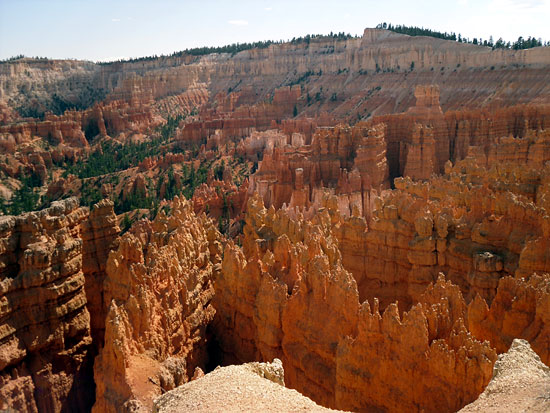
View Comments
John Treadwell Dunbar is a freelance writer